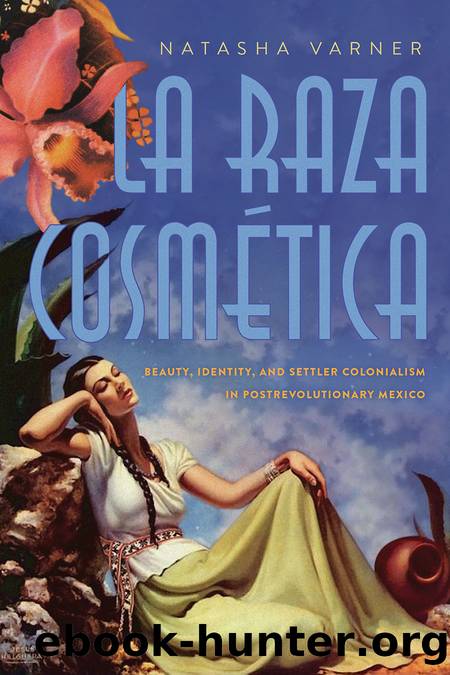La Raza Cosmética: Beauty, Identity, and Settler Colonialism in Postrevolutionary Mexico by Natasha Varner

Author:Natasha Varner [Varner, Natasha]
Language: eng
Format: epub
Tags: HIS025000 History / Latin America / Mexico, SOC062000 Social Science / Indigenous Studies
Publisher: University of Arizona Press
Published: 2020-10-06T00:00:00+00:00
âCalladita te ves más bonitaâ
Not all on-screen representations of Indigenous women were performed by mestiza actresses. In addition to appearances in documentaries, a rare pornography from the silent film era provides a glimpse into another way Indigenous women engaged with the film industry. The film La campesina is a complex and challenging piece of popular culture. Itâs the only film Iâve encountered from the era that casts a woman with darker skin and clearly Indigenous features in a leading role, and it includes much richer depictions of Indigenous love, joy, and pleasure than other Mexican-produced films from the era. But these nods toward humanizing and empowering Indigenous women are framed by the most graphic scenes of violence and pain seen in any of the sampling of silent pornographic films held at UNAMâs Filmoteca. The men in the film display a vexing combination of violence and tenderness, alternately doting on, attempting to pleasure, and abusing the female lead. And the male characters themselves are filmic aberrations, as it was rare to see rural-dwelling Indigenous men depicted as virile in postrevolutionary pop cultureâthey were more often shown to be either cartoonishly effeminate or drunken buffoons. Untangling the threads of each of these paradoxes lays bare some of the deeply contradictoryâand harmfulâthemes inherent in Mexican identity politics of the day.
La campesina runs just under eight minutes long, and though there are no credits indicating who produced it or when, it can most likely be dated to the 1920s or early 1930s.57 Shot in grainy 16 mm film on location in what appears to be the rolling hills of the altiplano, perhaps just outside of Mexico City, the film was made hastily with a lot of choppy cuts and seemingly little attention paid to shot construction. The director instead opted to âedit in cameraâ by trying many different shots and angles in short succession and applied relatively little postproduction refinement. Even so, the filmâs three unnamed actors are clearly skilled in silent film techniques, and it pays remarkable attention to narrative and character development for a pornographic film of that era.58 Given the quality of the production and complexity of the on-location set, it is possible it was an outtake from a longer commercial film or a side project made in haste after the feature production had wrapped.59 While these circumstances will probably never be fully known, what is clear is that this film was made quickly and crudely but that some planning and deliberation clearly went into its production.
In the opening scene of the film, the audience sees two lovers, Pancha and Prudencio, serenade one another amid the rolling hills of the campo. Their love seems innocent enoughâshe sings and he plays the flute and tenderly places his sombrero on her head in order to shield her from the sun. The scene is periodically interrupted with quick cuts to shots of another campesino, Gregorio, taking an ax to a tree. After the two lovers part, Pancha is taken by surprise by Gregorio, who has finished his dayâs work and apparently needs to immediately sate his manly desires.
Download
This site does not store any files on its server. We only index and link to content provided by other sites. Please contact the content providers to delete copyright contents if any and email us, we'll remove relevant links or contents immediately.
| Canada | Caribbean & West Indies |
| Central America | Greenland |
| Mexico | Native American |
| South America | United States |
Cat's cradle by Kurt Vonnegut(13869)
Pimp by Iceberg Slim(12934)
Underground: A Human History of the Worlds Beneath Our Feet by Will Hunt(11261)
4 3 2 1: A Novel by Paul Auster(11053)
The Radium Girls by Kate Moore(10909)
American History Stories, Volume III (Yesterday's Classics) by Pratt Mara L(4827)
Perfect Rhythm by Jae(4624)
Wiseguy by Nicholas Pileggi(4587)
The Fire Next Time by James Baldwin(4345)
Paper Towns by Green John(4170)
A Higher Loyalty: Truth, Lies, and Leadership by James Comey(4034)
Pale Blue Dot by Carl Sagan(4006)
The Mayflower and the Pilgrims' New World by Nathaniel Philbrick(3915)
The Doomsday Machine by Daniel Ellsberg(3733)
Too Much and Not the Mood by Durga Chew-Bose(3696)
Killers of the Flower Moon: The Osage Murders and the Birth of the FBI by David Grann(3611)
The Borden Murders by Sarah Miller(3591)
The Sympathizer by Viet Thanh Nguyen(3484)
Killing England by Bill O'Reilly(3456)
